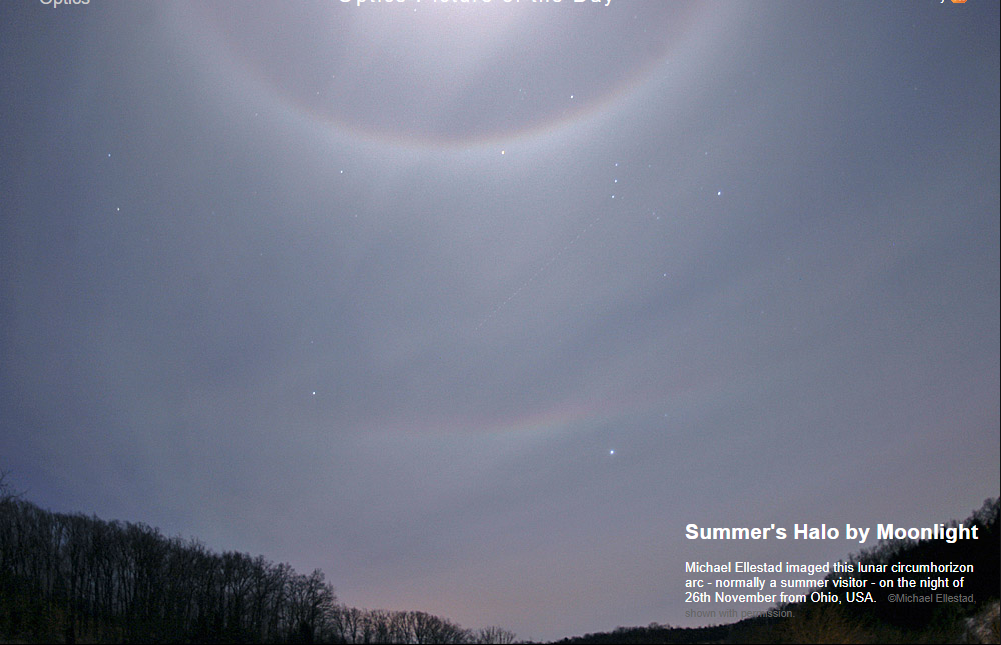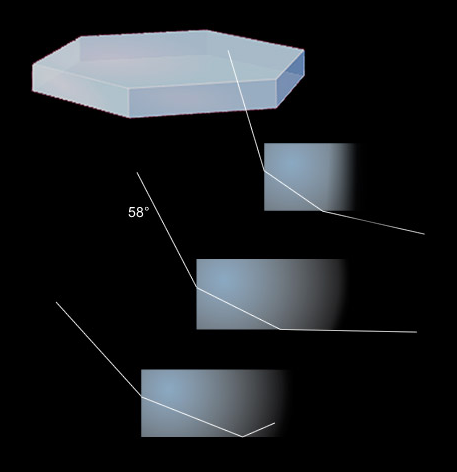OPOD - Summer's Halo by Moonlight
OPOD - Summer's Halo by Moonlight
Have you ever witnessed a stunning display of atmospheric optics known as the circumhorizon arc? This colossal and vibrant halo, which typically appears beneath the sun and runs parallel to the horizon, is a rare sight reserved for the summer months. However, there is another opportunity to observe this awe-inspiring phenomenon during the winter when the near full moon graces the night sky. In this article, we will delve into the intricacies of the lunar circumhorizon arc, its formation, and why it becomes visible during the colder months.
The circumhorizon arc forms when the sun is positioned higher than 58° in the sky. This means that it is predominantly a summer spectacle observed from locations in the mid-latitudes. However, during winter, the moon can rise even higher in the sky due to its orbit being inclined 5.1° to that of the ecliptic (the plane of Earth's orbit around the sun). As a result, areas that are typically deprived of witnessing the circumhorizon arc, such as northern Europe, have a unique opportunity to marvel at this captivating optical phenomenon.
The halo is created by rays of light entering the nearly vertical side faces of plate-shaped ice crystals and exiting through the base facet. When the sun or moon reaches an altitude of 58°, the emerging ray grazes the lower face of the crystal. However, at lower altitudes, the ray does not emerge at all but instead undergoes total internal reflection within the ice crystal.
To summarize, here are some key points about the lunar circumhorizon arc:
- The circumhorizon arc is a massive and vibrant halo that appears beneath the sun and parallel to the horizon.
- It is primarily visible during the summer months when the sun is positioned higher than 58°.
- However, during winter, the moon's higher position in the sky allows for the observation of this phenomenon.
- The moon's inclined orbit to the ecliptic provides areas like northern Europe with their only chance to witness the circumhorizon arc.
- The halo is formed by rays of light entering and exiting plate-shaped ice crystals.
- At an altitude of 58°, the emerging ray grazes the lower face of the crystal.
- At lower altitudes, the ray undergoes total internal reflection within the ice crystal.
In conclusion, the lunar circumhorizon arc is a breathtaking atmospheric optical display that offers a unique opportunity to witness the phenomenon during the winter months. As the moon rises high in the sky, it allows regions that are typically deprived of this spectacle to experience its beauty. Understanding the science behind the formation of the circumhorizon arc enhances our appreciation for the wonders of the natural world and reminds us of the intricate processes that shape our atmosphere. So, keep your eyes to the sky and be prepared to be captivated by this extraordinary sight when the conditions are just right.

Summer's Halo by Moonlight
Michael Ellestad imaged this lunar circumhorizon arc - normally a summer visitor - on the night of 26th November from Ohio, USA. ©Michael Ellestad, shown with permission.

The circumhorizon arc is a huge and colourful halo beneath the sun and running parallel to the horizon. It can only form when the sun is higher than 58° and is thus is purely summer sight from mid latitude locations. But in winter the near full moon rides high in the sky and offers another opportunity to see the arc.
The moon can be even higher than the summer sun because its orbit is inclined 5.1° to that of the ecliptic (the plane of Earth's orbit around the sun) allowing CHA deprived areas like northern Europe their only chance to see it.
Rays entering the near vertical side faces of plate shaped ice crystals and leaving through the base facet form the halo. When the sun or moon is 58° high the emerging ray grazes the lower face. At lower altitudes the ray does not emerge at all but is instead totally internally reflected.
Note: this article has been automatically converted from the old site and may not appear as intended. You can find the original article here.
Reference Atmospheric Optics
If you use any of the definitions, information, or data presented on Atmospheric Optics, please copy the link or reference below to properly credit us as the reference source. Thank you!
-
<a href="https://atoptics.co.uk/blog/opod-summers-halo-by-moonlight/">OPOD - Summer's Halo by Moonlight</a>
-
"OPOD - Summer's Halo by Moonlight". Atmospheric Optics. Accessed on November 26, 2024. https://atoptics.co.uk/blog/opod-summers-halo-by-moonlight/.
-
"OPOD - Summer's Halo by Moonlight". Atmospheric Optics, https://atoptics.co.uk/blog/opod-summers-halo-by-moonlight/. Accessed 26 November, 2024
-
OPOD - Summer's Halo by Moonlight. Atmospheric Optics. Retrieved from https://atoptics.co.uk/blog/opod-summers-halo-by-moonlight/.